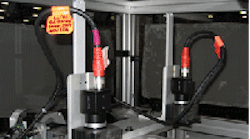Syringe manufacturers need to maintain high levels of quality in order to ensure the safety of patients and caregivers, while also maximizing productivity to deliver products at a competitive price. Machine Vision Inspection Stations from AVTEX, Burlington, Conn., were recently customized for a two-machine syringe assembly process coupled with a packaging system built by Arthur G. Russell Company (AGR), Bristol, Conn. The machine vision system, from Cognex Corp., Natick, Mass, performs a series of inspection operations, such as checking the presence and location of components, in as little as 50 ms.
“We used Cognex VisionPro software to develop six machine vision inspection stations for this machine,” says David Baker, AVTEX engineer. AGR’s process to produce syringes required two machines and 17 individual stations. The first machine indexes every two seconds and processes 16 syringes during each cycle for a total production rate of 480 syringes per minute. The needles, or cannula, are loaded into the first station of the machine. The needles are then picked up from a hopper by a vacuum gripper and the point end is inserted into a wheel. At the bottom of the wheel, needles are transferred to a belt to be presented to a vacuum pickup head.
At Station 2, the needles are picked up and rotated 90° and inserted into plastic hubs. Each hub includes a protector that is applied to the needle after it has been used to prevent accidents. Adhesive is applied to each hub-needle assembly in Station 3 and cured with ultraviolet light in Station 4. The needles could appear in the pallet at the first station of the machine at any angle. A machine vision system at Station 5 determines the angle of the needle. This operation occurs during the index of the machine, which constitutes 660 ms of the cycle, leaving only 41 ms for each needle to be inspected. AVTEX engineers created a custom lens light and selected a Sony XC-HR50 camera and Cognex VisionPro software to perform this inspection operation. The VisionPro PatMax pattern-matching tool was used to locate the part and report its orientation to the machine control system.
The programmers provide examples of good needles for training models used by PatMax, which uses geometric information in place of pixel grid-based correlation. For example, it interprets a square as four line segments and a football as two arcs. It does this by applying a three-step geometric measurement process to an object. PatMax identifies and isolates the key individual features within an object image and measures characteristics such as shape, dimensions, angle, arcs, and shading. It then correlates the spatial relationships between the key features of the trained image to the runtime image, encompassing both distance and relative angle. By analyzing the geometric information from both the features and spatial relationships, PatMax is able to precisely determine the object's position without regard to the object's angle, size, or appearance.
Station 6 uses a gripper arm driven by a servomotor to rotate the needle into the proper orientation for subsequent processing steps. This servo-driven assembly provides accurate high-speed needle handling. Station 7 is another machine vision station that verifies the needle orientation using the same camera and AVTEX software as Station 5. Station 8 uses VisionPro software to inspect the assembly to ensure that the hub has been securely fastened to the needle. Two Sony XC-HR50 cameras look at the assembly from the top and side views. The VisionPro software analyzes both images to determine whether or not a sufficient amount of adhesive has been applied in the right location.
At Station 9, another vision application backlights the pointed tip of the needle and checks to make sure it is intact. This station uses a grayscale blob tool to inspect the height and angle of the tip of the needle to check for problems such as the tip being folded over. At Station 10, a servo-driven gripper inserts shields over the tips of syringes that have passed all of the previous inspections. Station 11 is an unloading station in which a vacuum operated gripper head picks up the syringes that have passed inspection and puts them on a conveyor. The conveyor carries the syringes to a second machine that indexes every second. The machines provide the end-user with the ability to produce syringes at a rate of approximately twice the level that was possible in the past, and with twice the accuracy. For more information, visit Cognex Corp.

